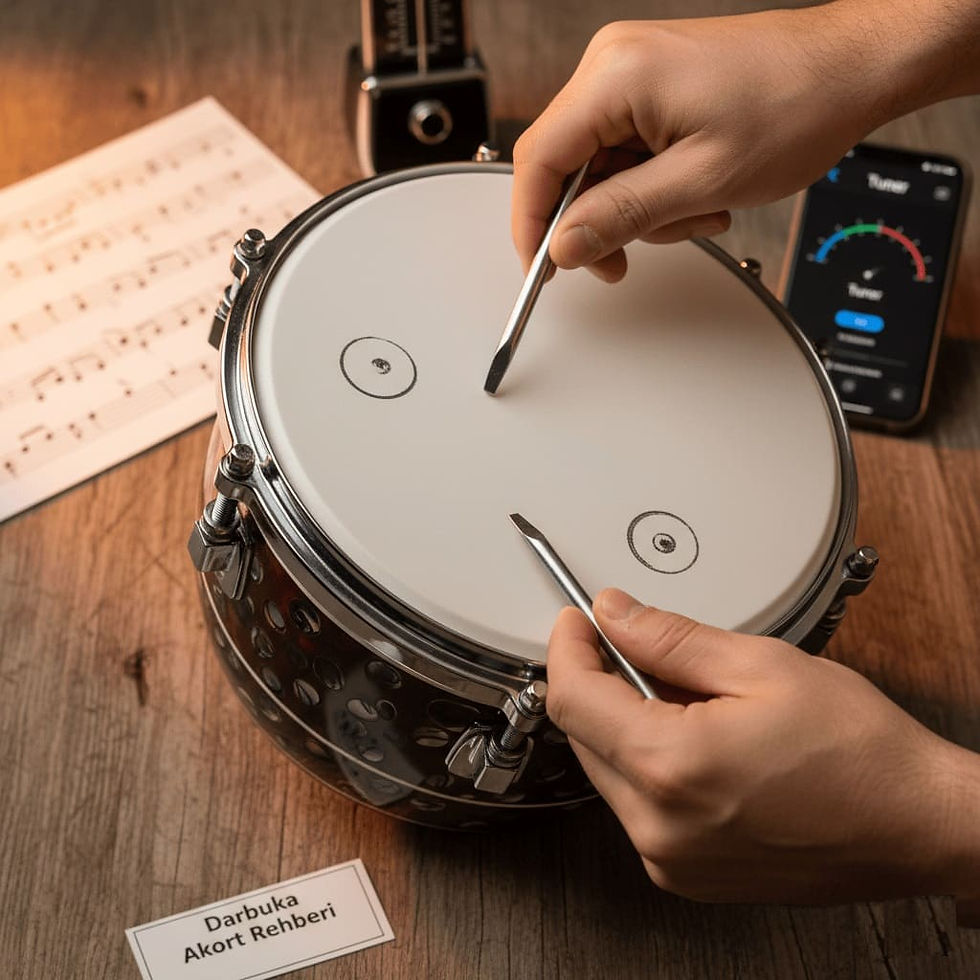Darbuka Tuning: Technical Details and Steps
- Donizetti Muzik
- Jul 21
- 4 min read
Updated: Nov 25
The darbuka is an important percussion instrument, widely used in Middle Eastern and Balkan music, providing rhythmic and melodic accompaniment. Accurate tone is crucial for both solo performances and ensemble harmony. In this article, we'll cover the technical details of tuning the darbuka and how to do it step by step.
The Importance of Darbuka Tuning
A properly tuned darbuka produces clear, resonant sounds, while an out-of-tune darbuka can sound weak, muffled, or have unwanted resonances. Tuning directly affects the balance of the "düm" (bass) and "tek" (treble) sounds produced by the darbuka. Good tuning adds depth to a performance and allows the player to showcase their techniques more effectively.

Darbuka Types and Tuning Mechanisms
Darbukas are generally divided into two main categories:
Leather Darbukas (Traditional): These darbukas typically have a skin made of natural (goat, fish, etc.) or synthetic leather. The skin is stretched over a hoop and tuned, usually by tightening it with a screw or string mechanism.
Synthetic Darbukas (Modern/Cast Iron): More common today, these darbukas feature durable synthetic skin (usually Mylar) and a modern tuning system, consisting of a metal ring and a series of screws, usually tightened with an Allen key or wrench .
In this article, we will focus on tuning synthetic darbukas, as tuning traditional leather darbukas is a different process (usually by heating or soaking) that requires more experience and precision.
Synthetic Darbuka Tuning Steps
Synthetic darbukas are tuned using similar principles to drums and percussion instruments. The primary goal is to maintain equal tension across the skin.
Required Tools:
Allen Key or Adjustable Wrench: It should be the appropriate size for the tuning pegs of your darbuka.
Optional: Digital Tuner: Can be useful for checking frets, especially for beginners.
Optional: Headphones or Quiet Environment: To hear the tuning more clearly.
Tuning Process:
Initial Tension (Relaxation):
Before starting to tune your darbuka, completely loosen all screws. Completely remove pressure from the skin. This will allow the skin to return to its natural position and create a starting point for equal tension. When loosening screws, it's generally a good practice to loosen opposing screws in turn.
Finger Squeeze (First Contact):
Begin finger-tightening each screw. Turn each screw clockwise until you feel slight resistance. Do not use a wrench at this stage. The goal is to ensure the leather fits into the hoop and create an initial even contact point between all the screws.
Quarter Turn Rule (Starting Tuning):
Now take your wrench. Starting with one screw, tighten it by turning it clockwise just a quarter turn (90 degrees) .
Important: Tighten the tuning pegs in a crisscross (opposite) pattern. That is, after tightening one screw, tighten the screw directly opposite (180 degrees). Then, move on to the next pair of crisscrossed pairs. This crisscross pattern ensures even tensioning of the leather and prevents wrinkles or uneven tension.
Apply this quarter-turn rule to all screws.
Control and Listening (Tone Creation):
After tightening all the screws a quarter-turn, tap the center of the tambourine and listen to the sound. If you find the sound still too quiet or loose, apply another quarter-turn to all the screws (again, in a crisscross pattern).
At this stage, you can begin listening for differences in sound by gently pressing the skin around each screw with your finger. The goal is to ensure that the sound from each point near the edges of the darbuka is as similar as possible. If a point sounds louder or quieter, you may need to slightly adjust the screw at that point.
Fine Tuning (Completing the Tuning):
Once you start getting close to the tone you want from the darbuka, adjust in much smaller steps (for example, an eighth of a turn or less).
Check the bass and treble notes. Generally, a tighter tuning produces a sharper, higher-pitched " tek " sound and a less resonant "düm" sound. A looser tuning produces a deeper, more resonant "düm" sound and a softer "tek" sound.
Gently tighten or loosen each screw (using very small movements!) to fine-tune the tension on the skin. Patience and careful listening are crucial at this stage.
Continue checking the tone by tapping or lightly pressing all points along the edges of the darbuka with your finger. Make sure the sound from all points is as uniform as possible.
Tips and Additional Information
Patience is Key: Tuning a darbuka requires practice. It may be difficult to achieve your desired tone at first, but with regular practice, your ear and feel will improve.
Make Small Adjustments: Always make small adjustments. Overtightening can damage or crack the leather.
Climatic Conditions: Leather tension can be affected by temperature and humidity. Natural leather darbukas are particularly susceptible to this. While synthetic leathers are more stable, minor adjustments may still be necessary during major climate changes.
Find the "Sweet Spot": Every darbuka and every skin has its own unique "sweet spot." This is the tuning level at which the darbuka sounds its best. Experiment with different tuning levels to discover your preferred sound.
Avoid Overtightening: Overtightening the leather shortens its lifespan and can even cause it to tear. It also negatively impacts sound quality.
Regular Inspection: Inspect your darbuka regularly. It can become out of tune over time, especially if it's an instrument that's played frequently.
Tuning your darbuka is fundamental to getting the best sound from your instrument. By following the steps and tips above, you can tune your darbuka correctly and add a richer dimension to your rhythms. Remember, the time you spend with your instrument and the care you give it will directly impact your playing enjoyment.




Comments